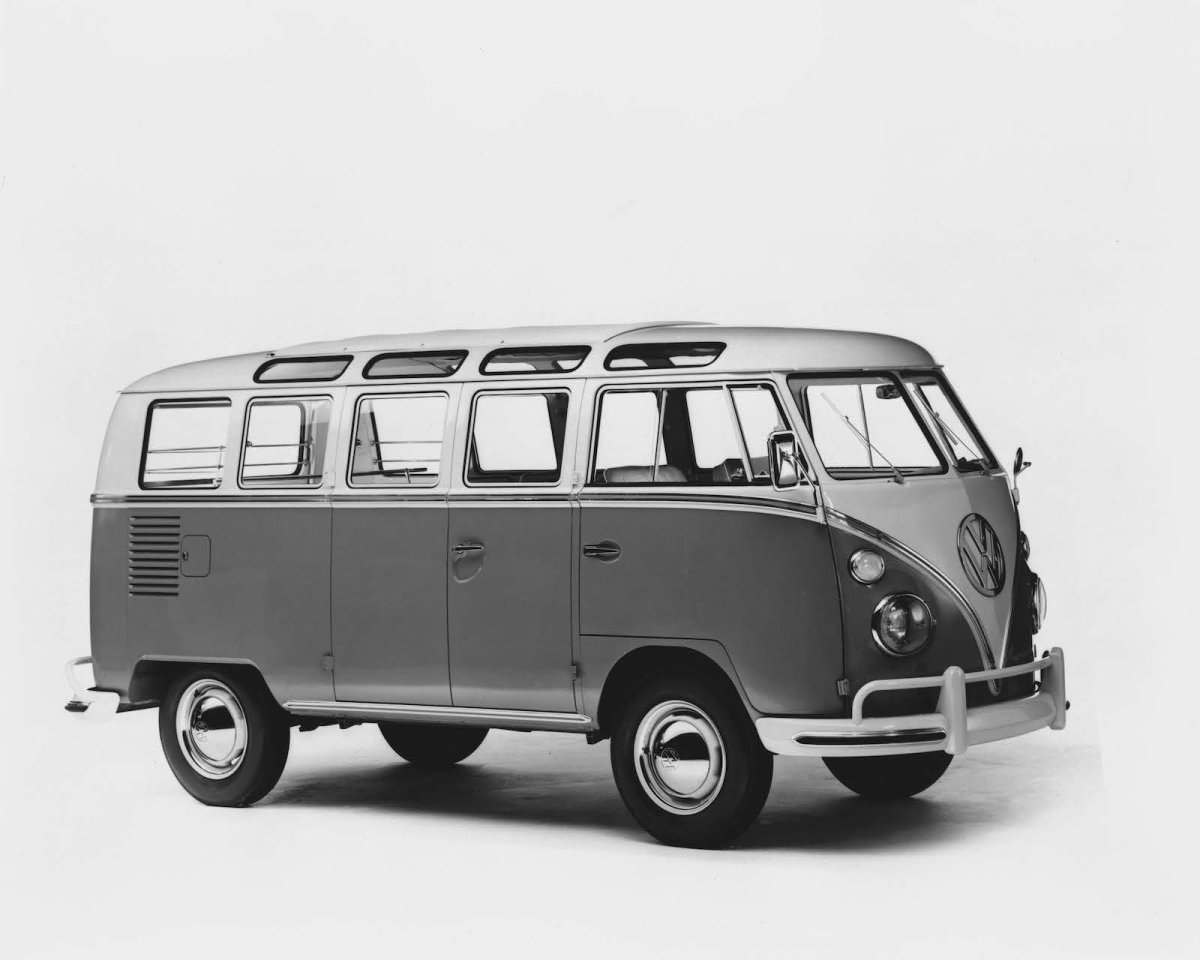Next year, the Volkswagen bus will make its return to the United States, this time with electric underpinnings.
The 2024 Volkswagen ID.Buzz, built using VW's electric MEB platform, is the latest in the company's long history with passenger and cargo vans.
Here's a history of the VW Bus.
Type 2

In 1946, Dutch VW importer Ben Pons traveled to Wolfsburg, Germany to buy a handful of Type 1s, more commonly known as the Beetle. While there, he saw a custom-built factory vehicle called the Plattewagen. He later sketched the bus, the company's engineers further refined the design, and the Type 2 was put into production in 1949.
The first generation Type 2, or Bus as it was called in the U.S., was made from 1950 to 1967. They could also be had as single-cab utility pickups or the Sunroof Deluxe upscale version.
The bus featured a rear-mounted engine and 23 windows.
During the '60s, the Type 2 was an unlikely focal point of U.S. trade policy as different countries fought over the import and export of chickens.
U.S. post-World War II production of chicken led to a sharp increase in exports to Europe. European countries complained that the U.S. was overloading their markets and harming domestic chicken producers.
The European Economic Community, a precursor to the European Union, imposed tariffs on U.S. chicken in 1963. A short time afterward, President Lyndon Johnson responded with tariffs on several products, including light trucks.
The VW Type 2 was classified as a light truck, and as a result the van's presence was reduced significantly in the U.S. market.
The second generation debuted in 1967, with the most significant difference between it and the first generation being the switch to a single glass panel for the windshield.
During that second generation, the bus became a countercultural touchstone as a symbol of the hippie movement and surf culture.

In 2019, a replica of the original "Light" bus, a Type 2 painted by Dr. Bob Hieronimus that appeared at Woodstock and became a symbol of the era, was shown off at a Bus enthusiast's meeting in California.
Three years prior, Hieronimus and documentarian John Wesley began a search for the original van. When it couldn't be found, they bought an identical Bus and recreated the work.
Hieronimus was originally asked to paint the van in 1968.
Type 3
That was followed by the Vanagon for the third generation, which held that classic VW van shape until production ended in 2002. It was the last VW van with an air-cooled engine, which was eventually phased out for a still-rear-mounted boxer-type engine.
Type 4
From 1992 to 2003, the Type 4 was exported to the U.S. as the EuroVan. Four models of the EuroVan were sold throughout that run: the seven-seater EuroVan CL, GL and GLS, EuroVan MV with rear-facing second-row seats, the EuroVan MV Weekender and EuroVan Camper.
The EuroVan Camper was a Westfalia conversion that included a pop-top roof, seating for four, two beds, and additional items to enhance the camping experience.

Microbus Concept
Just as VW was ending production of the Type 2, the company unveiled the Microbus concept in 2001.
Billed as a "design study for the world of tomorrow" while also hearkening back to the traditional Type 2 styling, the van was scheduled for release in the American market in 2004. The project was delayed and eventually scrapped that year.
Bulli and BUDD-e
In the 2010s, VW displayed a few all-electric concepts based on the Microbus design.
At the 2011 Geneva Motor Show, the Bulli concept debuted, which was equipped with an 85-kW motor that was capable of a company-estimated 186 miles of range.
Bulli was also the first vehicle to showcase the company's then-forthcoming MEB electric vehicle platform.
That was followed up with the BUDD-e concept in 2016, which had a VW-stated range of 233 miles.
Neither concept made it to production.
ID.BUZZ

VW unveiled the latest all-electric edition of the van as a concept car in 2017. At the time, the company indicated that it would make an all-wheel drive version with a 111-kilowatt-hour (kWh) battery pack and a rear-wheel drive model with an 83-kWh battery.
The next year, an ID.BUZZ Cargo concept was shown with an estimated payload capacity of 1,760 lbs.
A Cargo prototype was then put to use in the U.S., as VW partnered with Nike to display it at multiple Nike store locations across the country.
On March 9, the bus will be shown publicly for the first time at the South by Southwest conference in Austin, Texas.
In the lead-up to that, the company says that versions of the battery will have a capacity of 48 kWh and 110 kWh. Those capacities are VW-estimated to 200 miles and 340 miles of range, respectively.
The ID.Buzz is currently slated for release for the 2024 model year.
Uncommon Knowledge
Newsweek is committed to challenging conventional wisdom and finding connections in the search for common ground.
Newsweek is committed to challenging conventional wisdom and finding connections in the search for common ground.
About the writer
To read how Newsweek uses AI as a newsroom tool, Click here.





